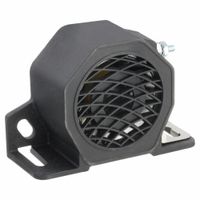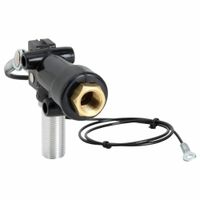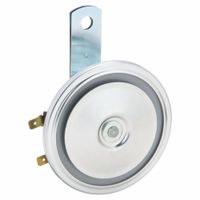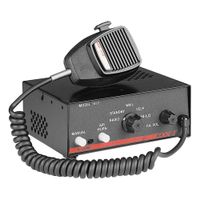Call +(254) 703 030 000 / 751 483 999 / 721 704 777
- Home
- Fleet Vehicle Maintenance
- Vehicle Accessories
- Vehicle Backup Alarms Horns Sirens
Vehicle Backup Alarms, Horns & Sirens
Backup alarms, horns, and sirens help prevent collisions by alerting pedestrians and other motorists of a vehicle's movement. Backup alarm systems emit an audible warning for reversing vehicles to prevent injury to personnel or damage to property. Horns help drivers and equipment operators to alert .....Read More
Frequently Asked Questions
What is the purpose of backup alarms on vehicles?
The purpose of backup alarms on vehicles is to enhance safety by alerting nearby pedestrians, workers, and other vehicles of a vehicle's reverse movement. These alarms are particularly crucial in environments such as construction sites, warehouses, and busy urban areas where visibility may be limited and the risk of accidents is higher. Backup alarms serve several key functions:
1. **Accident Prevention**: By emitting a loud, distinctive sound when a vehicle is reversing, backup alarms help prevent collisions with people, objects, or other vehicles. This is especially important for large vehicles with significant blind spots.
2. **Awareness**: They increase situational awareness for both the vehicle operator and those in the vicinity. The sound acts as a warning signal, prompting individuals to be cautious and attentive to the reversing vehicle.
3. **Compliance with Regulations**: Many regions have safety regulations that mandate the use of backup alarms on certain types of vehicles, particularly those used in industrial or construction settings. Compliance with these regulations helps ensure a safer working environment and reduces liability for companies.
4. **Enhanced Communication**: In noisy environments, visual cues alone may not be sufficient to alert individuals of a reversing vehicle. The auditory signal from a backup alarm cuts through ambient noise, providing an additional layer of communication.
5. **Safety Culture**: The use of backup alarms reinforces a culture of safety within organizations, emphasizing the importance of proactive measures to protect workers and the public.
Overall, backup alarms are a critical safety feature that contribute to reducing the risk of accidents and injuries associated with vehicle reversing operations.
How do backup alarms help prevent accidents?
Backup alarms help prevent accidents by providing an audible warning signal to alert individuals in the vicinity of a reversing vehicle. These alarms are particularly crucial in environments such as construction sites, warehouses, and loading docks, where heavy machinery and vehicles frequently operate in reverse. The primary function of backup alarms is to enhance situational awareness for both operators and nearby pedestrians or workers.
When a vehicle is put into reverse, the backup alarm emits a loud, distinct sound that can be heard over ambient noise, signaling that the vehicle is moving backward. This warning allows pedestrians and other workers to take precautionary measures to avoid being in the path of the reversing vehicle, thereby reducing the risk of collisions and injuries.
Backup alarms also serve as a reminder to the vehicle operator to remain vigilant while reversing. The sound prompts the driver to check mirrors, cameras, and blind spots, ensuring that the path is clear before proceeding. This dual function of alerting both the operator and those nearby significantly enhances safety.
Moreover, backup alarms are designed to be universally recognizable, often using a beeping sound that is distinct from other noises in the environment. This universality ensures that even individuals who are unfamiliar with the specific worksite can understand the warning and react accordingly.
In summary, backup alarms are a critical safety feature that helps prevent accidents by providing an audible alert to both vehicle operators and nearby individuals, promoting awareness and encouraging safe practices in environments where reversing vehicles are common.
What are the different types of backup alarms available?
There are several types of backup alarms available, each designed to enhance safety by alerting individuals to the presence of a reversing vehicle. Here are the main types:
1. **Beeping Alarms**: These are the most common and emit a loud, repetitive beep when a vehicle is in reverse. The sound is easily recognizable and alerts nearby pedestrians and workers.
2. **White Noise Alarms**: These alarms produce a "shh-shh" sound that is less intrusive than traditional beeping alarms. The sound is directional, making it easier for individuals to locate the source.
3. **Multi-Frequency Alarms**: These alarms emit a range of frequencies, making them more effective in noisy environments. The varying frequencies ensure the alarm is heard over background noise.
4. **Smart Alarms**: These alarms adjust their volume based on ambient noise levels. In quieter environments, they emit a softer sound, while in noisy areas, they increase in volume to ensure they are heard.
5. **Voice Alarms**: Instead of a beep, these alarms use a recorded voice message to warn individuals. This can be more informative and less startling than traditional alarms.
6. **Visual Alarms**: Often used in conjunction with audible alarms, these include flashing lights to provide a visual warning of a reversing vehicle, useful in areas where noise pollution is a concern.
7. **Combination Alarms**: These integrate multiple alarm types, such as sound and light, to provide a comprehensive warning system.
8. **Proximity Sensors**: While not alarms per se, these systems alert drivers to obstacles behind the vehicle, often used in conjunction with audible alarms to enhance safety.
Each type of backup alarm has its own advantages and is chosen based on the specific needs of the environment and the vehicle.
How can I choose the right backup alarm for my vehicle?
To choose the right backup alarm for your vehicle, consider the following factors:
1. **Vehicle Type and Size**: Different vehicles require different alarm intensities. Larger vehicles like trucks or construction equipment need louder alarms, typically around 97-112 decibels, to ensure the sound is heard over engine noise and environmental sounds.
2. **Alarm Type**: Decide between a tonal alarm, which emits a constant beep, and a broadband alarm, which uses a white noise sound. Broadband alarms are often preferred in urban areas as they are less disruptive and more directional.
3. **Environment**: Consider the typical environment where the vehicle operates. In noisy areas, a louder alarm is necessary. In quieter settings, a softer alarm may suffice to avoid noise pollution.
4. **Weather Resistance**: Ensure the alarm is weatherproof, especially if the vehicle operates in harsh conditions. Look for alarms with a high IP (Ingress Protection) rating for dust and water resistance.
5. **Adjustability**: Some alarms offer adjustable volume settings, allowing you to tailor the sound level to different environments or regulations.
6. **Regulations and Compliance**: Check local and industry-specific regulations regarding backup alarms. Some areas have specific requirements for sound levels and types of alarms.
7. **Installation and Compatibility**: Ensure the alarm is compatible with your vehicle's electrical system and is easy to install. Some alarms are plug-and-play, while others may require professional installation.
8. **Durability and Warranty**: Choose a reliable brand known for durability. A good warranty can provide peace of mind regarding the product's longevity.
9. **Cost**: Balance cost with features and quality. While cheaper options are available, investing in a high-quality alarm can prevent future expenses related to replacements or fines.
By considering these factors, you can select a backup alarm that effectively enhances safety while meeting your specific needs.
Are there regulations or standards for backup alarms?
Yes, there are regulations and standards for backup alarms. In the United States, the Occupational Safety and Health Administration (OSHA) has specific requirements for backup alarms under 29 CFR 1926.601(b)(4) for construction vehicles. This regulation mandates that motor vehicles with an obstructed view to the rear must have a reverse signal alarm audible above the surrounding noise level or be backed up only when an observer signals that it is safe to do so.
Additionally, the Society of Automotive Engineers (SAE) provides standards for backup alarms, such as SAE J994, which specifies performance requirements for audible alarm systems used on off-road work machines. This standard outlines the sound level and frequency requirements to ensure the alarm is effective in alerting nearby individuals.
In Europe, the Machinery Directive 2006/42/EC requires that machinery, including vehicles, be designed and constructed to minimize risks, which can include the use of backup alarms. The directive emphasizes the importance of risk assessment and the implementation of safety measures, such as audible warnings, to protect workers.
Furthermore, the International Organization for Standardization (ISO) has standards like ISO 9533, which specifies the performance requirements for audible warning devices on earth-moving machinery, ensuring they are loud enough to be heard over ambient noise.
These regulations and standards aim to enhance safety by ensuring that backup alarms are effective in preventing accidents and injuries associated with reversing vehicles. Compliance with these requirements is crucial for employers and manufacturers to ensure the safety of workers and the general public.
How do I install a backup alarm on my vehicle?
1. **Gather Tools and Materials**: You'll need a backup alarm kit, drill, screwdriver, wire strippers, electrical tape, and connectors.
2. **Choose Alarm Location**: Select a spot at the rear of the vehicle, typically near the bumper, where the alarm will be audible but protected from damage.
3. **Mount the Alarm**: Drill holes if necessary and use screws to secure the alarm in place. Ensure it is facing outward for optimal sound projection.
4. **Locate Reverse Light Wires**: Access the vehicle's reverse light wiring, usually found in the trunk or under the rear bumper.
5. **Connect Wires**: Strip the insulation from the reverse light wire and the alarm's power wire. Use a connector to join them, ensuring a secure connection. Connect the alarm's ground wire to a metal part of the vehicle's frame.
6. **Test the Alarm**: Turn on the vehicle and shift into reverse. The alarm should activate. If not, check connections and ensure the alarm is properly grounded.
7. **Secure Wiring**: Use electrical tape to cover connections and prevent exposure. Tuck wires neatly to avoid interference with vehicle components.
8. **Final Check**: Test the alarm again to confirm functionality. Adjust the alarm's position if necessary for optimal sound.
9. **Reassemble Vehicle Parts**: If you removed any panels or parts to access wiring, reattach them securely.
10. **Safety Check**: Ensure all tools and materials are removed from the vehicle and that the alarm does not obstruct any vehicle functions.
What maintenance is required for backup alarms, horns, and sirens?
Maintenance for backup alarms, horns, and sirens involves several key steps to ensure they function properly and reliably:
1. **Regular Inspection**: Conduct visual and auditory inspections regularly to check for physical damage, corrosion, or wear. Ensure that all components are securely mounted and free from obstructions.
2. **Testing**: Perform functional tests to verify that the alarms, horns, and sirens emit sound at the correct volume and frequency. This should be done according to the manufacturer's recommendations or at least monthly.
3. **Cleaning**: Keep the devices clean from dust, dirt, and debris, which can affect sound quality and performance. Use a soft brush or cloth to gently clean the exterior.
4. **Electrical Connections**: Check all electrical connections for signs of corrosion or looseness. Tighten any loose connections and clean any corrosion with appropriate contact cleaner.
5. **Battery Check**: For battery-operated devices, regularly check the battery condition and replace them as needed. Ensure that backup batteries are also in good condition.
6. **Wiring Inspection**: Inspect wiring for signs of wear, fraying, or damage. Replace any damaged wires to prevent malfunctions.
7. **Environmental Considerations**: Ensure that the devices are suitable for the environmental conditions they are exposed to, such as extreme temperatures or moisture. Use protective covers if necessary.
8. **Documentation**: Keep detailed records of all maintenance activities, including inspections, tests, and repairs. This helps in tracking performance and planning future maintenance.
9. **Compliance**: Ensure that all maintenance activities comply with relevant safety standards and regulations, such as OSHA or local guidelines.
10. **Training**: Train personnel responsible for maintenance on proper procedures and safety precautions to prevent accidents and ensure effective maintenance.
Regular maintenance ensures that backup alarms, horns, and sirens remain reliable, enhancing safety and compliance in various environments.



